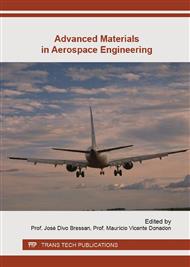[1]
R.R. Boyer, An overview on the use of titanium in the aerospace industry, Materials Science and Engineering A 213 (1996) 103-114.
Google Scholar
[2]
M.J. Donachie, Titanium: A technical guide, ASM, Ohio, (1988).
Google Scholar
[3]
T.S. Balasubramanian, M. Balakrishnan, V. Balasubramanian and M.A.M. Manickan, Effect of welding processes on joint characteristics of Ti-6Al-4V alloy, Science and Technology of Welding and Joining 16 (2011) 702-708.
DOI: 10.1179/1362171811y.0000000062
Google Scholar
[4]
X.L. Gao, L.J. Zhang, J. Liu and J.X. Zhang, A comparative study of pulsed Nd: YAG laser welding and TIG welding of thin Ti-6Al-4V titanium alloy plate, Mater. Sci. Eng. A 559 (2013) 1421.
DOI: 10.1016/j.msea.2012.06.016
Google Scholar
[5]
ASM Handbook, Selection and weldability of conventional titanium alloys. Welding, Brazing and Soldering, ASM, Ohio, v. 6, pp.507-523.
DOI: 10.31399/asm.hb.v06.a0001415
Google Scholar
[6]
E.W. Collings, The physical metallurgy of titanium alloys, ASM, Ohio, (1983).
Google Scholar
[7]
R. Filip, K. Kubiak, W. Ziaja and J. Sieniawaki, The effect of microstructure on the mechanical properties of two-phase titanium alloys, J Mater Process Technology 133 (2003) 84-89.
DOI: 10.1016/s0924-0136(02)00248-0
Google Scholar
[8]
X. Cao and M. Jahazi, Effect of welding speed on butt joint quality of Ti-6Al-4V alloy welded using high-power Nd: YAG laser; Optics and Lasers in Engineering 47 (2009) 1231-1241.
DOI: 10.1016/j.optlaseng.2009.05.010
Google Scholar
[9]
I. Katzarov, S. Malinov and W. Sha, Finite Element Modeling of the Morphology of β to α phase transformation in Ti-6Al-4V alloy, Metallurgical and Materials Transactions A 33 (2002) 1027-1040.
DOI: 10.1007/s11661-002-0204-4
Google Scholar
[10]
T. Ahmed and H. J. Rack, Phase transformations during cooling in α-β titanium alloys. Materials Science and Engineering A243 (1998) 206-211.
DOI: 10.1016/s0921-5093(97)00802-2
Google Scholar
[11]
B. Vrancken, L. Thijs, J.P. Kruth and J.V. Humbeeck, Heat treatment of Ti6Al4V produced by Selective Laser Melting: Microstructure and mechanical properties, Journal of Alloys and Compounds, 541 (2012) 177-185.
DOI: 10.1016/j.jallcom.2012.07.022
Google Scholar
[12]
B. Brushan and B.K. Gupta, Handbook of tribology: Materials, Coatings and Surface treatments, McGraw-Hill, New York, (1991).
Google Scholar
[13]
R.M. Oliveira, C.B. Mello, G. Silva, J.A.N. Gonçalves, M. Ueda and L. Pichon, Improved properties of Ti-6Al-4V by means of nitrogen high temperature plasma based ion implantation, Surface and Coating Technology 205 (2011) 111-114.
DOI: 10.1016/j.surfcoat.2011.03.029
Google Scholar
[14]
M.S.F. Lima, F. Folio and S. Mischer, Microstructure and surface properties of laser-remelted titanium nitride coatings on titanium, Surface and Coatings Technology 199 (2005) 83-91.
DOI: 10.1016/j.surfcoat.2004.08.206
Google Scholar
[15]
K. Farokhzadeh and A. Edrisy, Fatigue improvement in low temperature plasma nitride, Materials Science and Engineering A 620 (2015) 435-444.
DOI: 10.1016/j.msea.2014.10.008
Google Scholar
[16]
H.R. Simoni, M.S.F. Lima, A.J. Abdalla and W. Miyakawa, Study of Shielding Gas During Laser Welding of Ti-6Al-4V alloy. In: XXII International Materials Research Congress, CD.
Google Scholar
[17]
ASTM (2015) ASTM E8 / E8M - 13a Standard Test Methods for Tension Testing of Metallic Materials. Information on http: /www. astm. org/Standards/E8. htm. Accessed 30 May (2015).
DOI: 10.1520/jte20190549
Google Scholar
[18]
D.W. Cameron and D.W. Hoeppner, Fatigue Properties in Engineering, Fatigue and Fracture, Vol 19, ASM Handbook, ASM International, 1996, pp.15-26.
DOI: 10.31399/asm.hb.v19.a0002350
Google Scholar
[19]
Instruction Manual Model RBF-200 Rotating Beat, Fatigue Testing Machine Fatigue Dy namics, Inc., 2010, 13p.
Google Scholar
[20]
Information on http: /www. astm. org/Standards/E2948. htm.
Google Scholar
[21]
W. Weibull, Fatigue test and analysis test results, Pergamon, Oxford, 1961, pp.68-88.
Google Scholar
[22]
ASM Committee on metallurgy of titanium and titanium alloys, Metals Handbook, ed: 8, v. 7, 1972, pp.321-334.
Google Scholar
[23]
D.A. Porter and K.E. Easterling, Phase transformations in metals and alloys, CRC Press, London, 1992, pp.60-106.
Google Scholar


